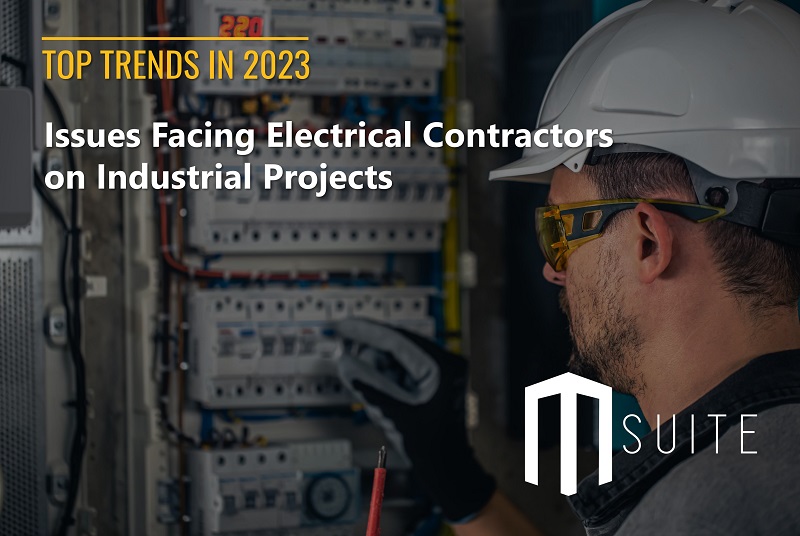There is no room for error in electrical contracting projects in industrial settings. They are highly complex and physically demanding, varying from chemical plants and production environments to plastic and rubber facilities. As a result, electrical contractors with experience and expertise matters more in these projects than in many other fields. If “company fit” isn’t one of the top criteria for securing the contract, the parties can run into countless problems (e.g., budget and schedule overruns, facility downtime, equipment damage, and failure) and, most concerning, accidents.
When electrical contractors are hired for an industrial project, the GC or Owner who hired them should feel confident they made the right decision. Why? Because time and time again, leading contractors require the capabilities to perform excellent work in ultra-demanding industrial environments.
Through research and conversations, we’ve identified a few of the top issues impacting electrical contracting projects related to industrial projects.
Challenge #1: Marketing your proven experience on industrial projects.
Possessing industrial expertise is one thing, but you need to promote them with vigor and feature past projects in detail, such as the scope of work, completion dates, and what stood out in terms of success factors that resonate with today’s customers. Older projects from ten years ago may not be relevant in 2022. Demonstrate the adaptability, creativity, and ingenuity of your firm on all digital (Website, Ads, etc.) and print marketing assets
Challenge #2: Controlling Costs.
One method for controlling costs is to consider prefabrication when appropriate. Many projects assemble their electrical material at a fabrication shop before installing it on the jobsite. Prefabrication (process, materials, delivery, technology, etc.) lowers labor costs and improves quality control. Many studies demonstrate that a work area designed for prefabrication allows for electrical material assembly at a fraction of the cost compared to assembly on the jobsite. With prefabrication, the on-site construction footprint is kept to a minimum, as there is less room for the assembly of electrical equipment, and less labor is needed on the jobsite. Additionally, jobsites remain clean due to less scrap material/garbage, which minimizes the risk of accidents and improves jobsite safety.
Challenge #3: Retirement of Aging Boomers
Another pressing issue that adds to the construction industry problems in 2023 is the retirement of aging boomers, the inflow of inexperienced workers, and the skilled labor shortage. Inexperience can also be a factor in an increasing number of injuries and accidents on jobsites. These factors must be addressed, with boomers primarily being managers, and their replacement is vital.
Challenge #4: Working in demanding environments.
The electrical contractors on industrial projects may work in extreme environments with 40-foot ceilings and higher elevations. Also, industrial installations typically call for rigid conduits instead of metallic electrical tubing (EMT). It takes substantial physical strength and skill to manipulate those large cables. Other installations include explosion-proof installs in large power plants and require unique training and skills. Additionally, some industrial settings need masks and other protective gear.
Challenge #5: Executing electrical requirements with or without complete drawings.
Believe it or not, sometimes only old drawings are available, so lean on your capabilities and expertise to get the project back up and running without new engineering drawings. In some cases, electrical equipment sits idle for years in a facility and needs reconfiguring and working closely with the engineer to reinstall it minutes after it was engineered.
Industrial electrical contractors must demonstrate the adaptability, creativity, and ingenuity required to be successful on these projects. Qualified industrial electricians can help companies save significant dollars in the short and long term based on their expertise.
Challenge #6: Avoiding time delays and cost overruns.
Shutting a facility down for several days to perform upgrades is nerve-racking. However, delaying the project daily represents a significant financial loss for the customer. In addition, in industrial settings, there’s no time for on-the-job education for any trade, electrical included. Therefore, the electrical contracting firm you hire must have a proven track record of adhering to aggressive and strict time constraints.
Challenge #7: Ensuring continuity of work and processes in multiple locations.
Many electrical contractors don’t travel, so for projects like plant relocations, it’s a significant bonus to find an electrical contracting firm that not only disconnects your electronics, but then puts it all back together in the new location. Continuity provides customers great peace of mind.
Challenge #8: Maintaining safety throughout an industrial electrical contracting project.
Safety is critical for any project, but it’s even more so in industrial settings. Therefore, electrical contractors need to maintain an established and comprehensive safety program that ensures workers are adequately trained in all elements of safe work practices. This helps to mitigate jobsite accidents and keep project schedules and budgets on track.
Leading electrical contractors place the highest priority on providing employees with a clean and safe work environment. This commitment is underscored through the enforcement of company policy, state regulations, OSHA rules, and proper training.
Challenge #9: Grappling with Technology.
The last decade has seen a revolution in technology. Today’s influx of new technology—from Revit and BIM models to MSUITE and many others—and the speed at which it’s changing makes it extremely difficult for end-users to get their arms around it. Managing the technology side of the business while doing work is challenging. With all the cool new technology available—e.g., drone augmented reality glasses like the Microsoft HoloLens, fab shop productivity, etc., electrical contractors who are not retiring need to be tech-savvy to prioritize investments in technology based on ROI and determine if the technology is just a flash in the pan or an interim solution versus something that’s ‘foundational and integrated’ that you can build on—inefficient administration.







